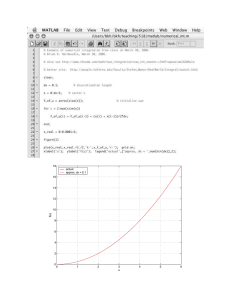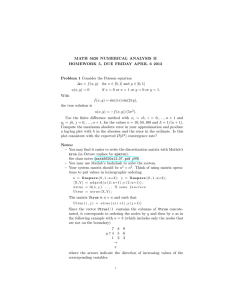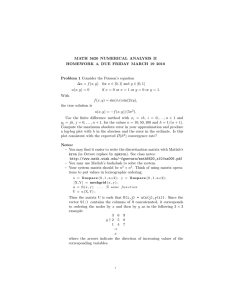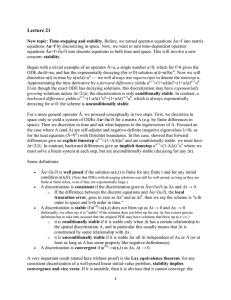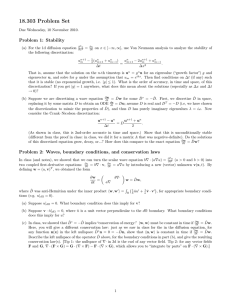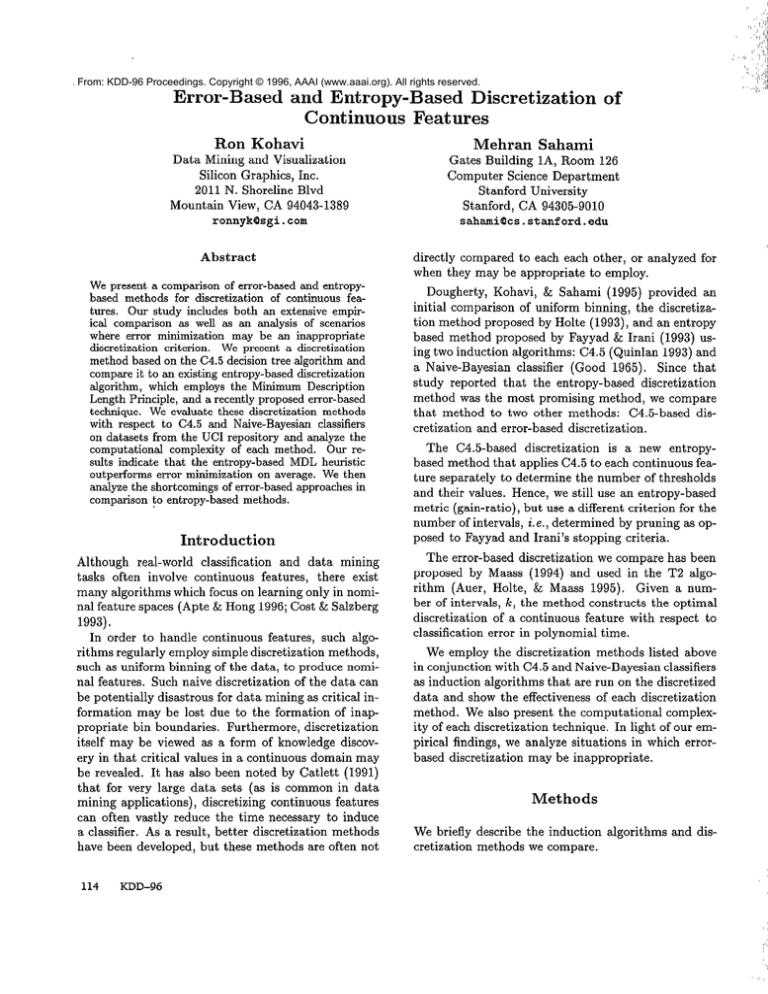
From: KDD-96 Proceedings. Copyright © 1996, AAAI (www.aaai.org). All rights reserved.
Error-Based
Ron
and Entropy-Based
Discretization
Continuous
Features
Kohavi
Mehran
Mining and Visualization
Silicon Graphics, Inc.
2011 N. Shoreline Blvd
Mountain
View, CA 94043-1389
rnnnvbfi@ai
#-nIlI
-v
..I. J”‘“b”
VI...
analyze the shortcomings of error-based approaches in
to entropy-based
nz,h=mi
63,-c
“U~&s%.lL~~h..3.
en+=n9nrA
YUa&.L”IU.
aA,r
vuu
directly compared to each each other, or analyzed for
when they may be appropriate to employ.
We present a comparison of error-based and entropybased methods for discretization
of continuous features. Our study includes both an extensive empirical comparison as well as an analysis of scenarios
where error minimization
may be an inappropriate
discretization
criterion.
We present a discretization
method based on the C4.5 decision tree algorithm and
compare it to an existing entropy-based discretization
algorithm, which employs the Minimum Description
Length Principle, and a recently proposed error-based
technique. We evaluate these discretization methods
with respect to C4.5 and Naive-Bayesian classifiers
on datasets from the UC1 repository and analyze the
computational
complexity of each method.
Our results indicate that the entropy-based MDL heuristic
outperforms error minimization
on average. We then
comparison
Sahami
Gates Building lA, Room 126
Computer Science Department
Stanford University
Stanford, CA 94305-9010
Data
Abstract
of
methods.
Dougherty, Kohavi, & Sahami (1995) provided an
initial comparison of uniform binning, the discretization method proposed by Holte (1993)) and an entropy
based method proposed by Fayyad & Irani (1993) using two induction algorithms: C4.5 (Quinlan 1993) and
a Naive-Bayesian classifier (Good 1965). Since that
-L.-A-. reportea
..-.--.A--, 6na6
L*~-L 6ne
L1-- entropy-oases
--~I~~~~~~
1 ~~~ 1 aiscretization
1.
stuay
method was the most promising method, we compare
that method to two other methods: C4.5-based discretization and error-based discretization.
The C4.5-based discretization
is a new entropybased method that applies C4.5 to each continuous feature separately to determine the number of thresholds
and their values. Hence, we still use an entropy-based
metric
(gain-ratio),
but use a different
criterion
for the
number of intervals, i.e., determined by pruning as opT-L-^1m.-L:-IIIbruuucbIuu
Although
real-world
classification
and data mining
tasks often involve continuous
features,
there exist
many algorithms which focus on learning only in nominal feature spaces (Apte & Hong 1996; Cost & Salzberg
1993).
In order to handle continuous features, such algorithms regularly employ simple discretization methods,
such as uniform binning of the data, to produce nominal features. Such naive discretization
of the data can
he
n,+cmti~llrr
vu ~“““‘I”IcuIIJ
rlin~~trm,~
U‘
VcuU”l”U”
ffiv
IVI
rlst.
m;n;na ‘16 .A”
IE Atbsl
;nUsu”Lu
11111”
L.AI.JI”L”I 111
formation may be lost due to the formation of inappropriate bin boundaries. Furthermore, discretization
itself may be viewed as a form of knowledge discovery in that critical values in a continuous domain may
be revealed. It has also been noted by Catlett (1991)
that for very large data sets (as is common in data
mining applications), discretizing continuous features
can often vastly reduce the time necessary to induce
a classifier. As a result, better discretization methods
have been developed, but these methods are often not
114
KDD-96
nnaerl
y-“-Y
fn
av~m-l
rrnrl Trani’
a Y dnnnincr
“V Ti’
4. CVJ
J Lsu WA&..
AL-AA1
YY.,yy”‘c,
rritmia
Y&A”“LIIY.
The error-based discretization we compare has been
proposed by Maass (1994) and used in the T2 algorithm (Auer, Holte, & Maass 1995). Given a number of intervals, K, the method constructs the optimal
discretization of a continuous feature with respect to
classification error in polynomial time.
We employ the discretization methods listed above
with C4.5 and Naive-Bayesian classifiers
as induction algorithms that are run on the discretized
in conjunction
cl-t%
uwvw
cam.4
UllU
chrrrrr
“II”..
tha
VllU
,&c.rti~mn~nn
“IIU~VAv~nIb””
nf
“I
acarh
tic&L41
cl;nrrntinat;nn
uI”~I~“IYcuuI”II
method. We also present the computational complexity of each discretization technique. In light of our empirical findings, we analyze situations in which errorbased discretization may be inappropriate.
Methods
We briefly describe the induction
cretization methods we compare.
algorithms
and dis-
Induction
Algorithms
In our experimental study, we test different discretization methods as applied to C4.5 and Naive-Bayesian
classifiers. C4.5 (Quinlan 1993) is a state-of-the-art
top-down decision tree induction algorithm. When we
discretize features, we declare them nominal, thus C4.5
does a multi-way split on all possible thresholds.
The Naive-Bayesian induction algorithm computes
the posterior probability of the classes given the data,
assuming independence between the features for each
class. The probabilities for nominal features are estimated using counts and a Gaussian distribution is
assumed for continuous features (in the undiscretized
cases). The Naive-Bayesian classifier used in our experiments is the one implemented in MU++
(Kohavi
et al. 1994).
Discretization
Algorithms
We focus on two discretization methods using entropy
and a recently developed error-based discretization
method. These methods are described below. A comprehensive review of the existing discretization literaI-.-,rnnr\
6ure 1IS I-....
iouna-1:.m n-.---.L-.
uougnerty, TI-l---.1
nonavl, uo- c1-I--.--!
3anarm \luuo~.
Fayyad and Irani’s
Method
First, we consider
discretization
based on an entropy minimization
heuristic proposed by Fayyad & Irani (1993). The
method is similar to that of Catlett (1991) but offers a
more motivated heuristic for deciding on the number
of intervals. This algorithm uses the class information entropy of candidate partitions to select threshold
boundaries for discretization. It finds a single threshold that minimizes the entropy function over all possible thresholds; it is then recursively applied to both
of the partitions induced. The Manamal Descraptaon
Length Principle (MDLP) is employed to determine a
stopping criteria for the recursive discretization strategy. We refer to this algorithm as Ent-MDL.
In our implementation, each split considered in the
entropy method takes O(mlogm)
time, where m is
the number of instances and when we assume a fixed
number of classes. If the method chooses k thresholds, then at most 2k + 1 threshold computations are
done. Hence, an upper bound on the time complexity
is O(kmlog m). This bound could be improved using
a smarter implementation
that would sort only once.
If we assume that the thresholds form a balanced tree,
then the time to sort the instances at a given level
is O(mlogm)
and the time bound can be reduced to
O(log k umlogm).
In practice, we expect the behavior to be somewhere between these two bounds. The
space complexity of this method is O(m) because only
the feature value and label of each instance is stored.
C4.5 Discretization
The C4.5 decision tree induction algorithm can also be used as a discretization
method. In this sense, C4.5 is first applied to each
continuous feature sepcmrately to build a tree which
contains binary splits that only test the single continuous feature. The C4.5 algorithm uses gain-ratio,
an entropy-based metric, to determine the partitions
for discrete intervals. We refer to this new method as
C,$.S-Disc.
This method is significantly different from that of
Fayyad & Irani (1993) in that the latter employs a
top-down stopping criterion based on MDLP, whereas
applying C4.5 to a single feature builds a complete
tree for that feature and then applies pruning to find
an appropriate number of nodes in the tree (i.e., the
number of discretization intervals) in a bottom-up approach. After the tree for a single feature is built and
pruned using C4.5, we can simply use the threshold values at each node of the induced tree to be the threshold
values for a discretization of that continuous feature.
We found that C4.5’~ default pruning confidence (the
c parameter) was not pruning enough and forced it to
pruned more heavily in order to prevent forming many
:,tm.,,,l,
‘7,.
th;o
no+ thn
m.mGrl~n-,.
P-etnm
+r.
lll”rjlYUIIO.
I”
UlllU onA
GULL) .r,n
WC D~U “UC L”II‘LUGllLl?
Ia&,lJ”I
U”
1 (down from 25). Minor variations of the c value did
not have much effect on our experiments. To prevent
“overfitting” this value, we did not try to optimize it
for our experiments.
The time complexity to discretize features using
C4.5 requires that a full single-feature tree be built
and then pruned back. The build time dominates the
pruning time, but even if only k intervals are finally
returned, many more must be constructed. If we assume that at least some constant portion p of the instances (say 10%) are split off each time, then the time
bound is O(log,~~,-,l m . m log m) because there can
be at most log,,(,-,)
m levels in the tree, each taking
O(m log m) time. The space complexity of the C4.5
discretization is O(m) because only the feature value
and label of each instance must be stored.
Error-based
Discretization
Significant work in
error-based discretization has only recently been carried out. Maass (1994) developed an algorithm to optimally discretize a continuous feature with respect to
error on the training set. This algorithm discretizes a
continuous feature by producing an optimal set of k or
fewer intervals that results in the minimum error on
the training set if the instances were to be classified
using only that single feature after discretization. We
refer to this algorithm as ErrorMin.
The maximum
number of intervals k is a user-set parameter.
This method has been implemented as part of the
T2 induction algorithm (Auer, Holte, & Maass 1995)
Decision-Tree Q Rule Induction
115
which induces one or two level decision trees. T2 circumvented the difficulty of providing a good justification for the value of Ic by simply setting k to be the
number of classes plus one. The algorithm employs
a dynamic programming approach to efficiently compute the optimal error discretization thresholds. Under the T2 heuristic the time complexity of the algorithm is O(m(logm + k2)) and the space complexity
is O(m + k3), where m is the number of training instances.
We used the implementation of this algorithm from
the T2 induction system, but tried two different approaches to setting the value for k. The first approach
is the one proposed for T2 described above, which we
call ErrorMin-T2.
The second approach is to set k
to be the same number of intervals proposed by running the Ent-MDL method, which allows us to compare them for the same k values; we call this method
ErrorMin-MDL.
Results
We begin by presenting the experimental
then analyze them.
Empirical
results and
Findings
Table 1 shows the datasets we chose for our comparison. We chose 17 datasets from the UC1 repository (Murphy & Aha 1996) such that each had at
least one continuous feature. We used lo-fold crossvalidation to determine error rates for the application
of each discretization and induction method pair to
each dataset. It is important to note that in performing
cross-validation we separately discretized the training
set for each fold. Discretizing all the data once before
creating the folds for cross-validation allows the discretization method to have access to the testing data,
which is known to result in optimistic error rates.
Figure 1 shows the results for C4.5. We report the
error rate for each discretization method used in conjunction with C4.5, normalized by the error rate of
the original C4.5 run on the data without any prior
discretization. Thus, the relative error bars below 1.0
show an improvement over C4.5 without discretization,
whereas values above 1.0 show a degradation in classification performance. More generally, lower values are
better. Figure 2 shows the analogous table for NaiveBayes, normalized by the error rate for Naive-Bayes
using the normal distribution (Gaussian) for continuous features.
The results for C4.5 show that Ent-MDL does better on average than C4.5 run without discretization,
lowering error rate in several instances and never significantly increasing it. C4.5 run using Ent-MDL some-
116
KDD-96
times significantly outperforms C4.5 alone because discretization provides a regularization effect (all the data
is used to determine the interval boundaries before
training, as opposed to during training where the
data is fragmented). The absolute average errors were
16.01% and 17.50% respectively, with the following pvalues for the significant differences computed using
a t-test: Ionosphere improved with p-value = 0.02,
Glass2 improved with p-value = 0.03, and Cleve improved with p-value = 0.05. Ent-MDL was, on average, also the best performing discretization method of
the four methods we tried. This is a noteworthy result
given that this method is entropy-based and does not
attempt to directly minimize error, our overall objective function. Looking at all the discretization algorithms, error rates increased significantly only in a few
cases and in many cases they slightly decreased.
For the ErrorMin method, Hypothyroid and Sickeuthyroid degraded significantly. For hypothyroid, the
relative difference is significant with p-value < 0.0002.
We examined the discretization methods carefully and
noted that with only two features: TSH and FTI, the
error of C4.5 is almost as good as with all the features. The Erroriviin
algorithm discretizes the TSH
feature into only two intervals (for all ten folds) even
though both heuristics (T2 and MDL) recommended
three intervals. The reason for this problem is that
ErrorMin will never create two adjacent intervals with
the same majority class. We explore the impact of this
phenomenon in an artificial example.
As reported in previous work (Dougherty, Kohavi,
& Sahami 1995), any form of discretization produced
large improvements over the Naive-Bayesian algorithm
with the normality assumption for continuous variables. Discretization allows for the algorithm to better approximate the true distribution for a continuous
variable when that distribution is not normal and thus
computes a more accurate posterior probability for an
instance to be of a particular class. In the rare cases
where the continuous features of a domain are in fact
normally distributed (as is the case with Iris and six
out of eight features in Diabetes), we find that discretieation causes a small increase in error rate, but
these are much more the exception than the norm. We
find that when discretization is applied, error rates
are lower for nine domains, relatively unchanged in
six domains, and only worse in two domains. All the
discretization methods performed approximately the
same, but Ent-MDL was a slight winner on average.
Also, worth noting is that Naive Bayes run using EntMDL sometimes significantly outperformed C4.5. For
example, performance on Anneal, Cleve, and Glass was
better with p-values less than 0.01, and performance
on Breast, Diabetes, Glass, and Heart was better with
p-values less than 0.05.
The running times for many of these experiments
were negligible. The most time intensive datasets to
discretize using Ent-MDL were Sick-euthyroid and Hypothyroid, which each took about 31 seconds per fold
on an SGI Challenge. The longest running time for ErrorMin was encountered with the Glass dataset which
took 153 seconds per fold to discretize, although this
was much longer than any other of the datasets examined. The ErrorMin method could not be run on the
Letter domain with 300MB of main memory.
Error
Observation:
ErrorMzn
will never generate two adjacent intervals with the same label.
The reason is that these two intervals can always be
collapsed into one interval with no degradation in the
error. We can thus see an inherent limitation of ErrorMin.
The implication is that out of eight possible labelings for three intervals in a two-class problem,
only two are possible with ErrorMin.
Entropy-based
Akrr&v.atinn
met.hnA~
have
nn
snrh
limit.nt.inn
U~V”~““IYIy”I”~A 1LLV”IIVU” II_. Y A-Y “U”AA . ..-~AYuY‘Y*- nnrl
I.._ can
VW-1
partition the space as long as the class distribution between the different partitions is different.
We generated 5,000 instances (uniformly randomly
distributed) from this target concept and ran lo-fold
cross-validation using ErrorMin-T2
and Ent-MDL.
KDD-96
I
I
,
class0
0
class 1 +
1
0.8
M
0.6
0.4
0.2
n
0
0.2
0.4
0.6
0.8'
1
Xl
vs. Entropy
To better understand why the entropy-based methods
outperformed ErrorMin on some datasets, and why
ErrorMin would not discretize to the suggested number of intervals, we present a simple example to show
the shortcomings of error-based discretization.
Consider a Boolean target function f of two continuous variables, Xr and X2 in the range [0, 11, defined as:
f(Xl,Xz)
= ((Xl < 0.4)A(Xa < 0.75))V(Xz < 0.25).
The function and its nroiection
on Xx are shown in
r--s----Figure 3. Note that f has only two intervals of interest
for X1 (with threshold 0.4), but three intervals of interest for X2 (with thresholds 0.25 and 0.75). ErrorMin
is unable to form the three intervals for X2. For this
function, all instances which have Xs < 0.25 will be
positive whereas all instances which have X2 >_ 0.75
will be negative. This leaves a large middle interval
(0.25 2 X2 < 0.75) where instances will either be labeled positive or negative depending on their value for
feature XI. Assuming a uniform distribution of instances, the middle interval will generally have more
negative instances. As a result, we will have a majority of negative instances in two adjacent partitions,
which is problematic for ErrorMin as the following observation shows.
118
I
1.2 -
,
I
I
I
1.2 -
I
I
I
I
I
class 0 0
class 1 +
0.8
S-2
0.6
0.4
-d
50 1001502002~~3003504iXi450500
Instancenumber
Figure 3: 500 instances from the artificial target concept
f (top) and its projection on the second feature (bottom).
Note that in the projection all instances below 0.25 are one
class, all instances above 0.75 are of the other, and in the
range 0.25-0.75,
they are mixed.
The ErrorMin- TZ heuristic recommends three intervals for each feature because this is a two-class problem. For X1, ErrorMin-T2
returns three intervals (although there are really only two) in nine out of the ten
folds. The second threshold was always very close to
the edge at 1.0. As mentioned above, ErrorMin-T2
returns only two intervals for Xs in all ten folds, although
there are three. The Bayes-error rate for the partitions
returned by ErrorMin-T2
was 10.24%. Ent-MDL, on
the other hand, found the correct number of partitions
and with thresholds very close to the true values. The
Bayes-error rate for the partitions returned by EntMDL was 0.02%.
We conclude that although error-minimization
n;nr,on
“Iyubu
~lwc,xra
Lu‘.“UJU
Gnrl
11.111 th.a
““C. mAmc.1
“y”““cy‘
n,,tit;.-m
IJCM Y‘Y‘““
tn
U” rnrlr.rn
I.dUU.db
techI-ho
““b
training-set error for each feature, entropy-based methods might fare better in practice because of feature
interaction:
as long as the distribution
is different
enough, a threshold will be formed, allowing other features to make the final discrimination.
Conclusions
References
Dougherty, Kohavi, & Sahami (1995) describe three
axes along which discretization methods can be measured: supervised vs. unsupervised, global vs. local, and
static vs. dynamic. The methods examined here are
supervised, as they make use of the instance label information while performing discretization, whereas unsupervised methods, such as equal width binning, do
not. We did not compare unsupervised methods as the
previous work noted that supervised methods have a
tendency to work better in practice.
The distinction between global and local methods
stems from when discretization is performed. Global
discretization involves discretizing all continuous features prior to induction. Local methods, on the other
hand, carry out discretization
during the induction
process, where particular local regions of the instance
space may be discretized differently (such as when C4.5
splits the same continuous feature differently down different branches of a decision tree). All the methods
compared here are applied globally. In future work
we aim to measure the effectiveness of these methods
when applied locally.
Discretization methods often require a parameter,
k, indicating the maximum number of intervals to produce in discretizing a feature. Static methods, such as
those examined in this work, perform one discretization pass of the data for each feature and determine
the value of k for each feature independent of the other
features. Dynamic methods conduct a search through
the space of possible k values for all features simultaneously, thereby capturing interdependencies in feature discretization.
During the course of this study,
we looked at dynamic versions of several discretization
methods, using the wrapper approach (John, Kohavi,
& Pfleger 1994) as a means of searching through the
space of the number of discretization intervals for all
variables simultaneously. We found no significant improvement in employing dynamic discretization over
its static counterpart.
Our results show that Ent-MDL is slightly superior
to the other methods for the datasets used. We have
also described why ErrorMin methods are inappropriate in cases where features interact, and analyzed the
time and space complexity of the different algorithms.
A~lrnnwlnrlcrm~nta
~~“...-‘
““‘““b”“““-
We
T ine
, , ” t,hn.nk
1----__- --‘
--- Getnnr
--1---
for corn-
ments on an earlier version of this paper and Peter
Auer for providing us with the code for T2. The second
author is supported by an ARPA/NASA/NSF
grant to
the Stanford Digital Libraries Project. All the experiments reported here were done using M.LC++.
Apte, C., and Hong, S. 1996. Predicting equity returns from security data. In Advances in Icnowledge
Discovery and Data Mining. AAAI Press and the MIT
Press. chapter 22, 541-569.
Auer, P.; Holte, R.; and Maass, W. 1995. Theory
and applications of agnostic pat-learning with small
decision trees. In Machine Learnzng: Proceedings of
the Twelfth Int. Conference. Morgan Kaufmann.
Catlett, J. 1991. On changing continuous attributes
into ordered discrete attributes.
In Kodratoff, Y.,
ed., Proceedings of the European Working Session on
Learning, 164-178. Berlin: Springer-Verlag.
Cost, S., and Salzberg, S. 1993. A weighted nearest neighbor algorithm for learning with symbolic features. Machzne Learning 10(1):57-78.
Dougherty, J.; Kohavi, R.; and Sahami, M. 1995.
Supervised and unsupervised discretization of continuous features. In Machine Learning: Proceedings of
the Twelfth Int. Conference, 194-202. Morgan Kaufmann.
Fayyad, U. M.! and Irani, K. B.
1993. Multiinterval discretization of continuous-valued attributes
for classification learning. In Proceedings of the 13th
Int. Joint Conference on Artificial Intelligence, 10221027. Morgan Kaufmann.
Good, I. J. 1965. The Estimation of Probabilities: An
Essay on Modern Bayesian Methods. M.I.T. Press.
Holte, R. C. 1993. Very simpleclassification
rules perform well on most commonly used datasets. Machine
Learning 11:63-90.
John, G.; Kohivi, R.; and Pfleger, K. 1994. Irrelevant features and the subset selection problem. In
Machine Learning: Proceedings of the Eleventh Int.
Conference, 121-129. Morgan Kaufmann.
Kohavi, R.; John, G.; Long, R.; Manley, D.; and
Pfleger, K.
1994. MLC++:
A machine learning library in C++.
In Tools with Artificial
Intelligence, 740-743. IEEE Computer Society Press.
http://www.sgi.com/Technology/mlc.
Maass, W. 1994. Efficient agnostic PAC-learning
with simple hypotheses. In Proceedings of the Seventh
Annual ACM Conference on Computational Learning
Theory, 67-75.
Murnhv.
M.. and
=--~, P.
-. -.-.,
-.-_-_-Aha.
.-.., -.D. W, 1996. UCI repository
of machine learning databases.
http://www.ics.uci.edu/-mlearn.
Quinlan,
Learning.
J. R. 1993. C4.5: Programs for Machine
Los Altos, California: Morgan Kaufmann.
Decision-Tree 6r Rule Induction
119

